Difference between revisions of "Madagascar cacao"
CampMaster (talk | contribs) |
CampMaster (talk | contribs) (→Additional information) |
||
| (34 intermediate revisions by the same user not shown) | |||
| Line 1: | Line 1: | ||
| + | '''Nearly all of Madagascar's cacao, including Criollo, Forastero and Trinitario, grow in the tropical humid northern [[Sambirano]] region of the country. Madagascan cacao is unusually non-bitter, making it especially suitable for making healthy and at the same time tasty chocolate or cocoa products with minimal sugar contents or entirely without sugar and other sweeteners. The peak harvesting seasons are between June and July and between October and November. ''' | ||
| + | |||
{| class="imageTable" | {| class="imageTable" | ||
|- | |- | ||
| Line 6: | Line 8: | ||
|align="center"|[[File:Sambirano_102.jpg|196px]] | |align="center"|[[File:Sambirano_102.jpg|196px]] | ||
|align="right"|[[File:Sambirano_104.jpg|196px]] | |align="right"|[[File:Sambirano_104.jpg|196px]] | ||
| + | |- | ||
|} | |} | ||
| − | ' | + | There are few privately owned cacao plantations in [[Ambanja]], such as [[Millot Plantation]]. Otherwise most cacao is produced by individual Malagasy farmers who live along the Sambirano River. The characteristics of Madagascar's cacao derives from the special soil conditions in the area. Once harvested, the cacao is sold to chocolate makers in Madagascar or exported as raw beans or processed cocoa. Cacao/cocoa producers and exporters in Madagascar include: |
* [[Chocolaterie Robert]] | * [[Chocolaterie Robert]] | ||
| Line 14: | Line 17: | ||
* [[SECAMAD]] | * [[SECAMAD]] | ||
* [[COCOMA]] | * [[COCOMA]] | ||
| + | * [[Ets THEODULE]] | ||
| + | * [[Madagascar Flavors MF]] | ||
| + | |||
| + | <HTML5video type="youtube" width="600" height="338">CCNGYAFy9J8</HTML5video> | ||
| + | |||
| + | {| class="imageTable" | ||
| + | |- | ||
| + | |colspan="3" | [[File:Andranomandevy_Ambanja_084.jpg|600px]] | ||
| + | |- | ||
| + | |[[File:Madagascar Cacao 001.jpg|196px]] | ||
| + | |align="center"|[[File:Ambodifinesy 011.jpg|196px]] | ||
| + | |align="right"|[[File:Madagascar Cacao 004.jpg|196px]] | ||
| + | |} | ||
| + | |||
| + | A small number of cacao plantations can also be found near [[Maroantsetra]] and [[Brickaville]], the latter being the location where cacao was originally introduced to Madagascar by French settlers. Additionally, cacao is grown in various locations in the SAVA region, such as along the Bemarivo River. | ||
| + | |||
| + | [[File:Marovato_Ambanja_016.jpg|600px]] | ||
| + | |||
| + | == Additional information == | ||
| + | |||
| + | * [[Sambirano Cocoa Tour]] by bike | ||
| + | * [[Sambirano Trekking Tour]] by foot passing many cacao plantations | ||
| + | * [http://www.worldbank.org/en/news/feature/2017/10/02/excellence-a-winning-formula-for-madagascan-cocoa-production.print Excellence: A Winning Formula for Madagascan Cocoa Production] 2nd October 2017, WorldBank.org | ||
| + | * View more [[Madagascar cacao photos]] | ||
| + | * [[Media:Cocoa production and processing.pdf|Cocoa production and processing]] by Kokou Edoh Adabe & E. Lionelle Ngo-Samnick on behalf of Engineers Without Borders, Cameroon (ISF Cameroun) and The Technical Centre for Agricultural and Rural Cooperation (CTA). | ||
| + | * https://perfectdailygrind.com/2018/08/is-criollo-chocolate-really-king-the-myth-of-the-3-cacao-varieties/ | ||
| + | * [[CNC]] – Conseil National du Cacao | ||
| + | * [[GACM]] – Groupement des acteurs du cacao à Madagascar | ||
Latest revision as of 13:27, 25 June 2024
Nearly all of Madagascar's cacao, including Criollo, Forastero and Trinitario, grow in the tropical humid northern Sambirano region of the country. Madagascan cacao is unusually non-bitter, making it especially suitable for making healthy and at the same time tasty chocolate or cocoa products with minimal sugar contents or entirely without sugar and other sweeteners. The peak harvesting seasons are between June and July and between October and November.
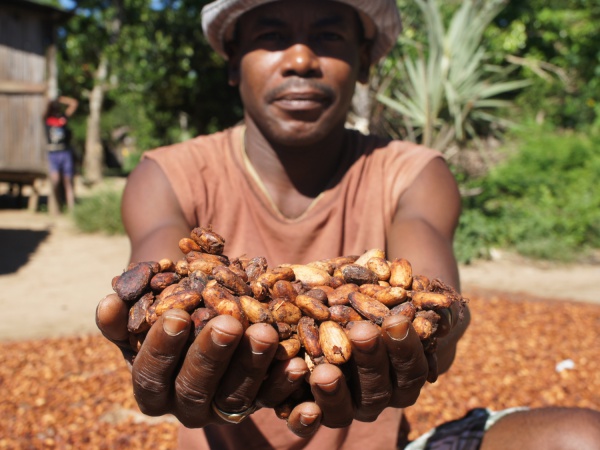
| ||
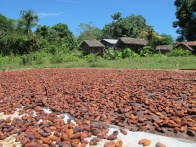
|
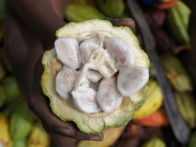
|
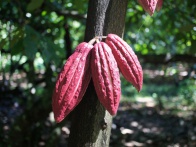
|
There are few privately owned cacao plantations in Ambanja, such as Millot Plantation. Otherwise most cacao is produced by individual Malagasy farmers who live along the Sambirano River. The characteristics of Madagascar's cacao derives from the special soil conditions in the area. Once harvested, the cacao is sold to chocolate makers in Madagascar or exported as raw beans or processed cocoa. Cacao/cocoa producers and exporters in Madagascar include:

| ||

|
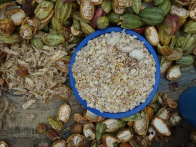
|
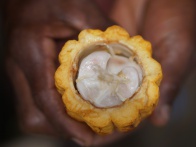
|
A small number of cacao plantations can also be found near Maroantsetra and Brickaville, the latter being the location where cacao was originally introduced to Madagascar by French settlers. Additionally, cacao is grown in various locations in the SAVA region, such as along the Bemarivo River.
Additional information
- Sambirano Cocoa Tour by bike
- Sambirano Trekking Tour by foot passing many cacao plantations
- Excellence: A Winning Formula for Madagascan Cocoa Production 2nd October 2017, WorldBank.org
- View more Madagascar cacao photos
- Cocoa production and processing by Kokou Edoh Adabe & E. Lionelle Ngo-Samnick on behalf of Engineers Without Borders, Cameroon (ISF Cameroun) and The Technical Centre for Agricultural and Rural Cooperation (CTA).
- https://perfectdailygrind.com/2018/08/is-criollo-chocolate-really-king-the-myth-of-the-3-cacao-varieties/
- CNC – Conseil National du Cacao
- GACM – Groupement des acteurs du cacao à Madagascar
